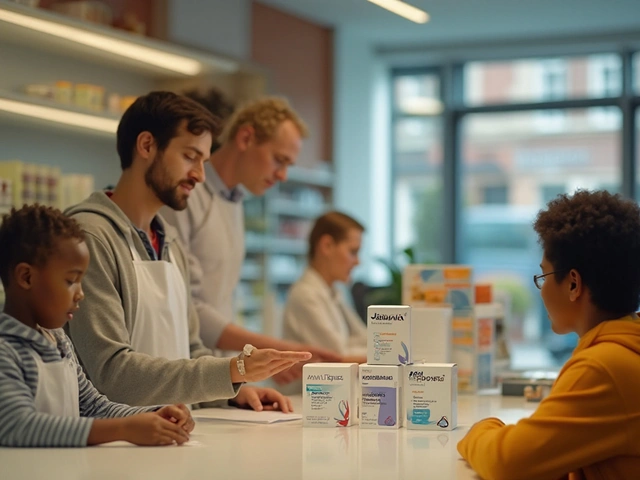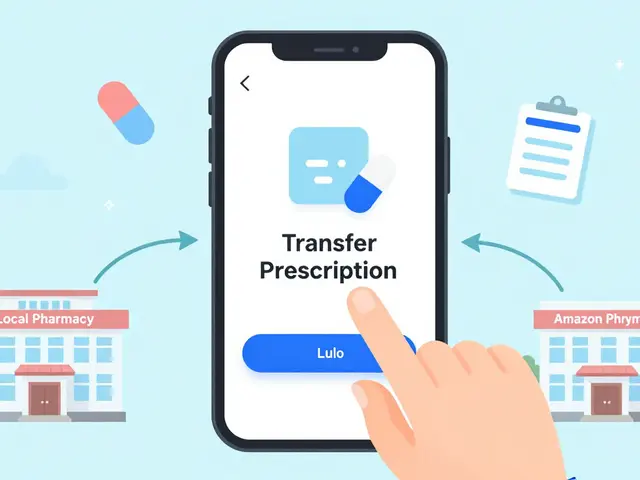Anthelmintic Selection Guide
Select the type of infection and patient details to get recommended anthelmintic treatment:
Biltricide is a praziquantel‑based anthelmintic that targets flatworms, especially Schistosoma species and various tapeworms. It works by increasing calcium ion permeability in the parasite’s membrane, leading to muscle contraction, paralysis, and eventual death. Approved by the U.S. Food and Drug Administration in 1991, Biltricide remains the frontline drug for treating schistosomiasis worldwide.
Why Compare Biltricide With Other Anthelmintics?
Clinicians often face questions like “Is praziquantel the only option?” or “When should I switch to another drug?” The answer depends on infection type, patient age, drug resistance patterns, and safety concerns. By laying out the main alternatives-albendazole, mebendazole, niclosamide, ivermectin, and triclabendazole-you can quickly decide which agent fits a given scenario.
Quick Takeaways
- Biltricide is most effective for schistosomiasis and most tapeworm infections.
- Albendazole and mebendazole excel against soil‑transmitted nematodes (hookworm, roundworm).
- Niclosamide is the drug of choice for fish‑borne tapeworms (Diphyllobothrium).
- Ivermectin dominates in treating onchocerciasis and strongyloidiasis.
- Triclabendazole is uniquely potent against liver fluke (Fasciola hepatica).
Core Alternatives Explained
Albendazole is a broad‑spectrum benzimidazole that interferes with microtubule formation in nematodes and some cestodes. The World Health Organization recommends it for hookworm, Ascaris, and neurocysticercosis.
Mebendazole shares the benzimidazole class but has a slightly different absorption profile, making it preferred for treating pediatric ascariasis and trichuriasis.
Niclosamide is a salicylanilide that uncouples oxidative phosphorylation in tapeworms, specifically eradicating diphyllobothriasis and taeniasis.
Ivermectin is a macrocyclic lactone that hyperpolarizes nerve and muscle cells of nematodes. It’s the gold standard for onchocerciasis, strongyloidiasis, and certain ectoparasites.
Triclabendazole belongs to the benzimidazole‑related class but is specially engineered to bind to liver fluke tubulin, offering single‑dose cure rates >95% for fascioliasis.
Head‑to‑Head Comparison
| Drug (Generic) | Class | Primary Indications | Typical Dose (mg/kg) | Common Side Effects | Regulatory Status (US) |
|---|---|---|---|---|---|
| Praziquantel (Biltricide) | Anthelmintic (tetrahydropyrimidine) | Schistosomiasis, cysticercosis, tapeworms | 40-60 (single dose) | Dizziness, nausea, abdominal pain | Approved |
| Albendazole | Benzimidazole | Hookworm, Ascaris, neurocysticercosis | 400mg twice daily for 3days | Headache, abdominal discomfort | Approved |
| Mebendazole | Benzimidazole | Ascariasis, trichuriasis | 100mg twice daily for 3days | Diarrhea, rash | Approved |
| Niclosamide | Salicylanilide | Diphyllobothriasis, taeniasis | 2g single dose | Transient GI upset | Approved |
| Ivermectin | Macrocyclic lactone | Onchocerciasis, strongyloidiasis | 200µg/kg single dose | Pruritus, mild fever | Approved |
| Triclabendazole | Benzimidazole‑related | Fascioliasis (liver fluke) | 10mg/kg single dose | Transient headache, nausea | Approved (orphan drug) |

How to Choose the Right Drug
Think of drug selection as a decision tree. First, identify the parasite type. If it’s a fluke (Schistosoma), praziquantel is unmatched. For nematodes like hookworm, albendazole or mebendazole are typically cheaper and have a solid safety record in children.
Second, consider resistance. In parts of East Africa, repeated praziquantel use has sparked low‑level resistance, prompting clinicians to rotate with oxamniquine (not covered here) or add a second‑line benzimidazole.
Third, weigh patient‑specific factors: pregnancy, liver function, and drug interactions. Albendazole is contraindicated in the first trimester, whereas praziquantel is generally safe throughout pregnancy according to WHO guidelines.
Safety Profiles and Contra‑indications
All anthelmintics share mild GI upset, but the severity varies. Praziquantel’s rapid tremor of the parasite’s musculature can cause transient hepatic enzyme spikes-important for patients on statins or anti‑epileptics.
Albendazole and mebendazole can cause bone‑marrow suppression at high cumulative doses, so routine blood counts are advised for prolonged therapy (e.g., cysticercosis). Niclosamide stays largely within the gut lumen, making systemic side effects rare, but it’s ineffective against tissue‑dwelling parasites.
Ivermectin’s neurotoxicity risk rises in patients with high blood‑brain barrier permeability (e.g., those with Loa loa infection). Triclabendazole, while highly effective, has been linked to rare hepatic injury, so baseline liver tests are prudent.
Real‑World Scenarios
Scenario1 - A 9‑year‑old in Kenya with confirmed Schistosoma mansoni. The recommended regimen is a single dose of praziquantel (40mg/kg). If the child has a documented allergy to praziquantel, an alternative such as oxamniquine could be explored, but albendazole would not be effective.
Scenario2 - A 45‑year‑old fisherman with diphyllobothriasis after eating raw fish. Niclosamide at 2g once cures >95% of cases. Praziquantel would work but requires multiple doses and carries more systemic side effects.
Scenario3 - A pregnant woman in her second trimester with onchocerciasis. Ivermectin is contraindicated during pregnancy; instead, a course of doxycycline (targeting Wolbachia bacteria) is recommended, highlighting that sometimes a non‑anthelmintic approach is safer.
Linking to the Bigger Picture
Understanding these drugs also helps you navigate related topics likemass drug administration (MDA) programs, the role of the World Health Organization in setting treatment guidelines, and emerging resistance monitoring efforts. If you’re curious about how praziquantel prices compare across low‑income markets, that’s a natural next read.
Bottom Line
While Biltricide (praziquantel) remains the go‑to therapy for many flatworm infections, a sensible clinician knows when a benzimidazole, salicylanilide, or macrocyclic lactone fits better. The decision hinges on parasite species, resistance patterns, patient health status, and regulatory availability. Keep this comparison table handy, and you’ll feel confident choosing the right antiparasitic every time.

Frequently Asked Questions
Can I take Biltricide with other medications?
Praziquantel can interact with drugs that affect liver enzymes (CYP3A4), such as some anti‑epileptics and antiretrovirals. A short course usually doesn’t require dosage changes, but always inform your doctor about existing prescriptions.
Is praziquantel safe for children?
Yes. WHO recommends praziquantel for children as young as six months, using weight‑based dosing. Side effects are mild and transient.
What should I do if treatment fails?
Failure can stem from resistance, incorrect dosing, or reinfection. Repeat dosing after a week, consider an alternative drug from the table, and investigate local resistance data.
Are there any natural remedies that replace praziquantel?
No natural product reliably kills adult schistosomes. Herbal extracts may support liver health, but they cannot substitute for a proven anthelmintic.
How is praziquantel supplied in low‑resource settings?
It’s often distributed as a 600mg tablet in mass‑drug administration campaigns, with dosing calculated by weight bands to simplify field logistics.
Does praziquantel treat intestinal tapeworms?
Yes, a single 10mg/kg dose clears most taeniasis cases, but for fish‑borne Diphyllobothrium infections niclosamide is often preferred.
What monitoring is needed after treatment?
A stool exam 4‑6weeks post‑treatment confirms cure for most helminths. For schistosomiasis, serology or antigen tests may be used to detect residual infection.



 Medications
Medications





Shana Shapiro '19
September 25, 2025 AT 21:29Reading through this guide felt like watching a life‑saving play unfold. The way you laid out the decision tree for each parasite is both clear and compassionate. I especially appreciated the emphasis on safety for pregnant women – that’s often the missing piece. Your table makes a clinician’s job feel a lot less daunting, and I can imagine it being a go‑to reference in busy clinics. Thank you for turning a complex subject into something we can all understand.
Jillian Bell
October 2, 2025 AT 20:09What most people don’t realize is that the “approved” label on Biltricide is just a front for big‑pharma’s profit machine. Those same companies fund the studies that say it’s safe, while quietly suppressing data on long‑term liver stress. If you dig deeper, you’ll see an entire network of lobbying that influences WHO guidelines. It’s a reminder to stay skeptical about any “one‑size‑fits‑all” drug narrative.
Lindsey Bollig
October 9, 2025 AT 18:49Quick tip for anyone prescribing praziquantel: split the dose into two half‑hour intervals if the patient reports nausea. It can make the gut a bit gentler on the meds and still hit the same therapeutic level. Also, for kids under 12 kg, a syrup formulation is now available in many countries, which helps with accurate dosing. Hope that helps anyone wrestling with the practical side of the guide!
David Brice
October 16, 2025 AT 17:29Great rundown! I’d add a note that in resource‑limited settings, you can often calculate doses using weight bands (e.g., 20‑30 kg gets 600 mg, 30‑40 kg gets 800 mg) to speed up mass‑drug administration. This little hack saved my team hours during a recent MDA campaign in rural Kenya. Also, keep an eye on local resistance reports – they can change the game fast.
Zachary Schroer
October 23, 2025 AT 16:09Praziquantel is a drug of the elite, nothing more.
Stacy Whitman
October 30, 2025 AT 13:49Our country should fund its own production instead of relying on foreign pharma.
Émilie Maurice
November 6, 2025 AT 12:29While your skepticism is noted, the claim that Biltricide’s safety data is “suppressed” lacks concrete evidence. Peer‑reviewed studies consistently show low incidence of serious adverse events. It's important to differentiate between legitimate caution and unfounded conspiracy.
Veronica Mayfair
November 13, 2025 AT 11:09Love the compassionate vibe! 🌟 Your guide makes the science feel human‑centered, and that’s exactly what patients need. Keep spreading the knowledge! 😊
Rahul Kr
November 20, 2025 AT 09:49Just a heads‑up: for patients with liver issues, checking baseline enzymes before giving praziquantel is a good practice. It’s a small step that can prevent larger worries later.
Anthony Coppedge
November 27, 2025 AT 08:29When it comes to selecting an anthelmintic, the clinician’s thought process often begins with a simple question: “What parasite am I dealing with?” From there, the answer branches into a cascade of considerations-patient age, pregnancy status, potential drug‑drug interactions, and regional resistance patterns. For schistosomiasis, praziquantel remains the gold standard because its mechanism of increasing calcium permeability effectively paralyzes adult worms, allowing the host’s immune system to clear them. However, it is crucial to remember that praziquantel’s rapid action can cause transient hepatic enzyme elevations, a point that is especially relevant for patients already on statins or other hepatically metabolized drugs. In the case of soil‑transmitted nematodes such as hookworm or Ascaris, the benzimidazoles-albendazole and mebendazole-offer broader tissue penetration and a well‑established safety profile in children, making them the preferred options. Niclosamide, on the other hand, stays largely within the gastrointestinal lumen, which is why it is superb for fish‑borne tapeworms but ineffective against tissue‑dwelling parasites like Schistosoma mansoni. Ivermectin’s macrocyclic lactone structure allows it to hyperpolarize nematode nerve cells, rendering it indispensable for strongyloidiasis and onchocerciasis, yet it must be avoided in pregnant women due to limited safety data. Triclabendazole’s specificity for Fasciola hepatica stems from its unique binding to fluke tubulin, delivering cure rates exceeding ninety‑five percent with a single dose-an impressive statistic that justifies its orphan‑drug status. When resistance looms, especially in East African schistosomiasis hotspots, rotating with oxamniquine or adding a benzimidazole can mitigate treatment failure, though local guidelines should always drive the final decision. Safety monitoring after treatment should include a follow‑up stool examination at four to six weeks for most helminths, while serologic testing may be required for schistosome infections to confirm eradication. It’s also worth noting that mass‑drug administration campaigns often employ weight‑band dosing to simplify logistics, which can introduce a small margin of error but vastly improves coverage. Ultimately, the choice of anthelmintic is a balance between efficacy, safety, cost, and availability, and a well‑structured decision tree-like the one you provided-serves as an invaluable tool for clinicians navigating this complex landscape.
Joshua Logronio
December 4, 2025 AT 07:09Heh, the “elite” drug thing is just marketing hype, bro.
Nicholas Blackburn
December 11, 2025 AT 05:49While your dosing tip is useful, you gloss over the fact that splitting praziquantel can actually reduce its efficacy against certain trematodes. The pharmacokinetics rely on a rapid peak concentration; halving the dose may give the parasite a chance to survive. Also, not every clinic has syrup formulations-many rural pharmacies only stock tablets, forcing providers to crush them, which can affect absorption. So, before recommending “split the dose,” consider the specific parasite and the formulation at hand.
Dave Barnes
December 18, 2025 AT 04:29Reading your deep dive feels like navigating a labyrinth of logic and biology-almost reminds me of how we search for meaning in chaos. In a way, choosing the right drug is like picking the right key for a lock; the lock itself is the parasite’s biology, and the key is the drug’s mechanism. If we ignore the subtle nuances you mention, we’re effectively throwing darts blindfolded. So kudos for laying out the map; now we just have to walk the path.
Kai Röder
December 25, 2025 AT 03:09Excellent synthesis, Dave. Your philosophical framing underscores the practical importance of a systematic approach. For clinicians, the takeaway is clear: integrate parasite biology, patient context, and regional data to guide therapy. This layered reasoning ensures we’re not just treating symptoms, but addressing the root cause with precision.